It is rare that I need to deal with major technical problems. I have an all in one computer and a laptop and for the last few years, everything has just worked.
However, when something does go wrong, it can put me behind on my workload. This kind of problem also cuts into my personal life as I need to spend so much time trying to resolve the issue. Unfortunately, that is what happened last week.
This blog post is a tale of what happens when your computer stops working. It is a tale of dogs, a packed work schedule, and why internet marketers need to be prepared for the worst.
I hope you enjoy it.
It’s a Doggy Dogg World
Two days ago, my parents returned from their holiday in Spain. They had been away for ten days to celebrate their ruby wedding anniversary (40 years of marriage – WOW!).
In order for them to go on holiday, myself and my girlfriend stayed over at their house to look after their two dogs. I don’t mind looking after the dogs as it allows them to get away and I love spending time with the dogs.
However, the dogs need a lot of attention. They need to be walked three or four times a day and fed at specific times. They are used to a certain routine and they are vocal when that routine breaks. This makes it very difficult for me to be productive.
The dogs always wake up around 7am and start making noises for us to get up and walk them. It doesn’t matter if I was up working until 4am or if I had taken them out at 12am or 1am to do the toilet; they will always get up at that time and will bark and bark until they are walked. In between walks, they always want you to play with them and focus your time on them.

I naturally gravitate towards a late working schedule. I always have (I wrote half this blog post at 5am!). So when I was walking the dogs, I would be tired after walking them in the morning and would try and catch a nap afterwards. The dogs would frequently wake me up by barking for attention; so many days I was exhausted. And when I am exhausted; I find it very difficult to write or get anything productive done.
My plan was to go back to my own house every day to get some work completed; however it never works out that way as it means coming and going between the houses four or five times per day. It is more practical for me to just work over there so that I can make sure they are ok.
Therefore, I rarely get much work done when I am watching the dogs for my parents. Inevitably, a backlog of work creeps in. While I find it difficult to do a lot of writing, I always respond to emails so that when I return to my own house, I can start getting through my backlog of articles quickly.
Over the last week, I found it difficult to even respond to all of my emails. The backlog was so bad that I had to email two clients and ask them to deliver articles to them four or five days later than expected (this is something I have only had to do on one other occasion). Thankfully, my clients were very understanding of my situation.
There were a number of reasons I fell behind with my work:
- I had posted an advertisement for a blogger on the ProBlogger job board and was getting 30 to 50 applications per day
- We had to go to the shops one day to buy gifts for my parent’s wedding anniversary
- I had to spend a day buying gifts as it was my girlfriend’s birthday
- My iMac refused to boot up
The last issue was what concerned me. I do not enjoy shopping, but I was able to get what I needed and move on. However, the issue with the iMac had the potential to be a real time drainer as it could mean replacing the hard drive and then spending a full day re-installing software and settings.
The Problem with My iMac
I purchased my 27″ iMac in January 2010. It is a late 2009 model with an 2.66 GHz Intel Core i5, an ATI Radeon HD 4850 512 MB graphics card, and an 1TB 7200RPM Hard drive.
I love its high quality screen and it has never given me any problems in the past. However, I was unable to boot up the computer when I switched it on last Saturday. The Apple logo would appear with a loading bar. The bar would get to about 5% to 10% of the way along and then the computer would just switch off.

I loaded up OS X Utilities by holding CMD and R.
The first option I was presented with was “Restore from Time Machine Backup”. It was at this point that I remembered that I have never got round to buying an external hard drive to store my data using Time Machine. Doh!
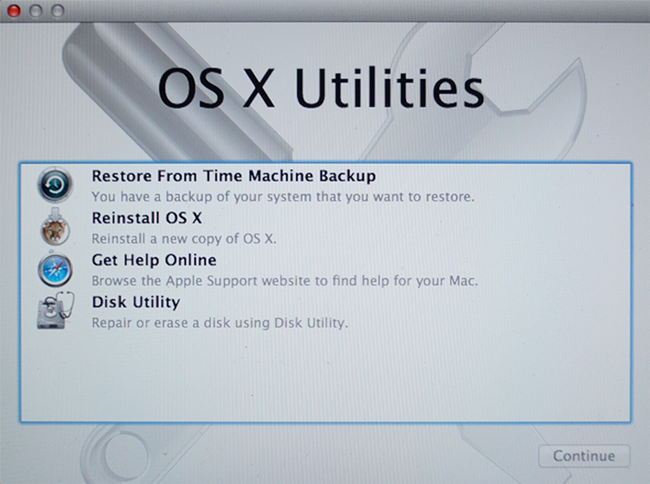
I was also unable to reinstall OS X. When I attempted it, I was informed that my hard drive was locked.
The disk utility tool is an application that can be accessed via the main applications folder on a mac. It showed that the recovery area was fine, but the main hard drive disk had failed.
I looked at dozens of threads online from other Mac users. The vast majority of people had found that their hard drive had failed.
This was not good news. Replacing a hard drive on a desktop computer is fairly painless. You simply open up the PC, take out the old hard, and then insert the new one. The process of replacing the hard drive on an iMac is much more difficult.
iFixit have a fantastic guide on how to replace the hard drive on a 27″ iMac, but the process requires me to use suction cups in order to remove the screen properly.
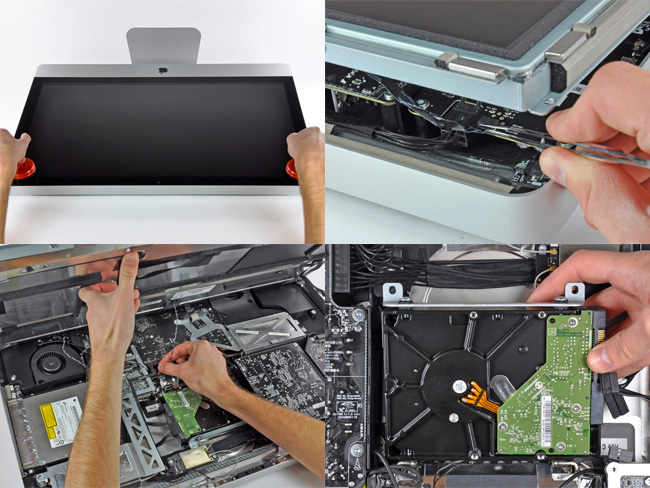
I am sure I would be able to replace the hard drive on my iMac. The guide from iFixit details everything I need to do and suction cups are not too expensive. Plus I have experience with upgrading computers. I used to build my own PC’s and have upgraded most of my laptop computers. Apart from upgrading RAM, the last major change I performed on my Lenovo X220 was replacing the sim card slot with an mSATA solid state drive to make it boot quicker.
So the thought of replacing the hard drive in my iMac does not concern me too much. In fact, I had looked into changing the drive in the past. I am only using around 350GB of my 1TB hard drive at the moment so do not need the extra storage, though I have looked into replacing the drive with an SSD to speed everything up.
What did concern me was that I did not have any way of booting up or restoring my files. I could not locate my original discs and every guide online that shows you how to create a USB boot disk required you to use a mac. The whole process is a pain.
Last Sunday, I was in Glasgow with my girlfriend, so I popped into the Apple store to see if one of their “Geniuses” could recommend a fix. His recommendation was to call the Apple Care hotline; which he noted would cost me £35. The second option was to bring my iMac in for them to check. Considering the size of the iMac, the fact that Glasgow is 19 miles from my home, and the fact that Apple charge too much for repairs; I did not want to go down that route.
Someone Up There Likes Me
On Wednesday I was looking at how I could try and boot my iMac up. There was a very good chance my hard drive was done, but I wanted to make sure by booting up via an OS X disc or an OS X USB boot drive.
I had turned to looking on torrent websites in order to create a USB boot disk via a Windows computer. I turned my iMac on at this point.
It worked.
I couldn’t believe it. There was some glitchy images and then my computer loaded up as if nothing had ever happened.
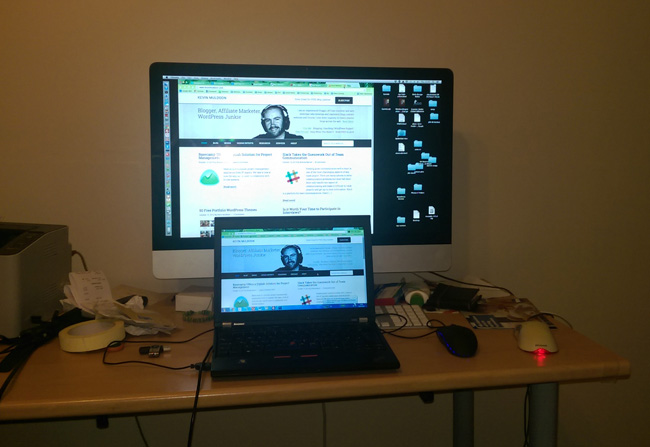
My guess is that a recent update of OS X failed for some reason (though I don’t know for sure). I used the Disk Utility tool afterwards and it said my drive is fine. The same tool had previously reported errors that would suggest that the drive cannot be saved.
My priority is to backup my computer on a regular basis and make sure that I am prepared for any problems in the future. I have created a recoveryUDB disk using OS X Recovery Disk Assistant. I am also looking at the best way to backup my hard drive using Time Machine (my friend Allan has gave me some good recommendations on the best drive to use).
The Downsides of All in One Computers and Laptops
I purchased my first computer in 1996 (the Commodore 64 I had in the 80s doesn’t count!). It was purchased with a student loan I got during my first year of University.
As you would expect from a computer back in the 90s, it was stupidly expensive for what you got. However, the PC taught me computing skills that I continue to use on a daily basis. It was not long until I was building my own PCs and upgrading older ones for family and friends.
I built my own computers for over ten years. However, before I set off on a trip to Asia and Australasia for close to a year, I had a couple of unlucky incidents with my desktop computer.
Over the course of a couple of months, a few different parts failed, such as the power supply. My family used my computer when I was away that year and the computer failed again. If I recall correctly, it was the motherboard that had died.
I was certainly unlucky to have so many parts fail. The cost of individual parts was not a major issue. What was a problem was the time and energy I spent on trying to fix the computer. Resolving very problem was a case of trial and error, therefore it could sometimes take me the best part of a day to figure out which part failed.
When I returned from my travels in 2007, I purchased the 15.4″ Asus G1 laptop. Whilst I loved doing upgrades, I had become frustrated by the whole process of fixing broken computers. My thinking was that a device such as a laptop would give me less problems. In truth, it has, which is why I have not built my own computer since.
The fact that my girlfriend continues to use the Asus G1 laptop every day, seven years after I bought the computer, illustrates that it was a good buy. The only problems we have with it are related to Windows Vista; which continues to be a temperamental operating system (to say the least).
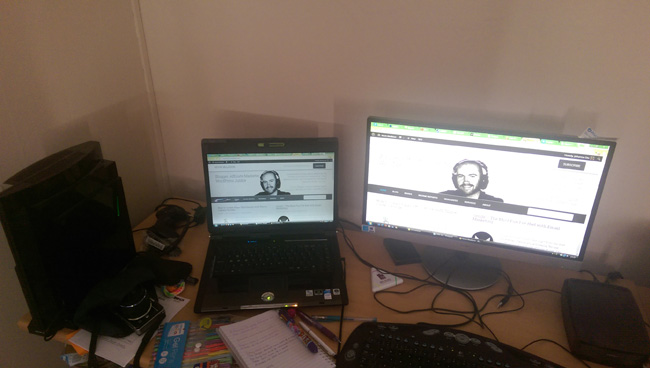
Two years after I bought the Asus laptop, I purchased my 27″ iMac. Despite the problem with booting up last week, I have not had any problems with it. There is no doubt that I have been lucky in that regard. I am fully aware that many people buy computers and see things such as hard drives and motherboards fail.
If something breaks within the first two years, you can send it back under warranty. It could take a few weeks to get your computer back, but this is a small price to pay if your computer gets repaired.
However, if your laptop or all in one computer fails outside of warranty, you could be screwed. Replacing RAM or a hard drive should not be a major problem, however if something else fails you could be out of luck as the parts may not be readily available. You may also find that key components have been soldered onto the motherboard; a necessary step when building something so compact, but a pain when trying to fix a broken computer.
It is at this point you will probably need to upgrade, however with a desktop computer you could replace fault parts more easily.
Considering that laptops are cheaper nowadays, perhaps it is best to replace them every four or five years. This could be a cost effective way to do it if you always buy the cheapest computer on offer; not so much if you are spending over two grand on a Macbook Pro or a top of the range Windows laptop.
Personally, I don’t like the idea of throwing out a good computer simply because one part failed; particularly if the machine is still good enough to be used on a daily basis. If I can fix the computer by buying the necessary part, I will. Perhaps that way of thinking comes from building my own computers in the past.
A Reminder to Always Be Prepared
I am pleased that the problem with my iMac was not as serious as I first thought. It could turn out to be a good thing as it has reminded me to always be prepared for the worst. You need a setup to backup important data on a regular basis.
Thankfully, preparing for a computing failure is very easy today. Ten years ago, I had to spend over £1,500 on a small Sony laptop as it was the only one that was both portable for travelling and powerful enough for me to work online. Today, you can walk into a supermarket and pick up a capable portable laptop for working online for around £250.
If you can afford it, I would recommend all internet marketers to have at least two computers available to them at home. That means that if one computer fails, you can continue to work using the other computer. I like my solution of a desktop in the office and a portable laptop for working downstairs or when travelling. However, when my iMac does need to be replaced, I will look into whether a desktop computer is the right solution. A laptop connected to a monitor might be much more flexible.
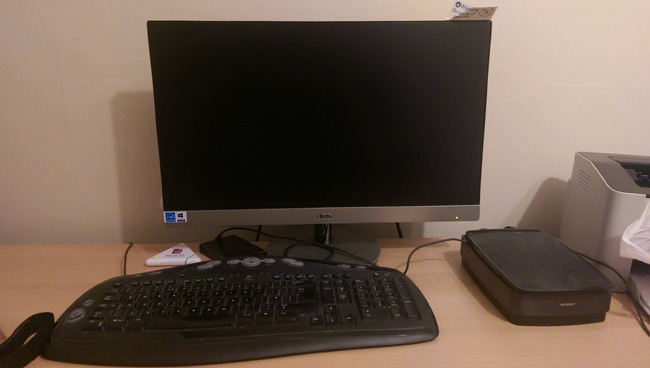
Backing up has come a long way too. All my important files are backed up to Dropbox and synced to all my devices; while VaultPress ensures all my WordPress websites are backed up on an hourly basis. My other websites are backed up to Amazon S3.
Large external hard drives and smaller USB powered hard drives have come down in price considerably too. Six years ago it cost me around £150 for a 320GB 2.5″ USB powered hard drive. Now I can buy a 1TB equivalent for around £45. I’m going to pick up a Firewire 800 compatible 2.5″ hard drive to backup my iMac every week using Time Machine. These retail for around £100.
From a blogging perspective, it is good to schedule blog posts ahead of time. A lot of new bloggers are helping me publish more great content on this blog. This will help me schedule articles three or four weeks in advance; which will be a great help if I fall sick or encounter another problem with my computer.
What set up do you currently use for working online? Do you backup regularly to external drives and to cloud services?
I would love to hear your thoughts on all of this, so please take the time to leave a comment below if you can :)
Thanks for reading.
Kevin

